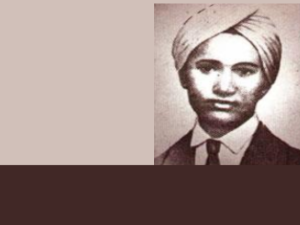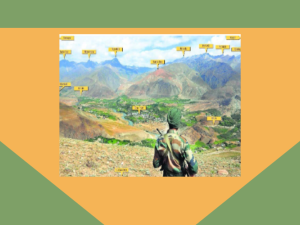Saka Nankana Sahib
The Jand tree to whom Bhai Lachhman Singh was tied and burnt alive
After paying my obeisance at the sanctum sanctorum, I came out of the other gate and came face to face with 'Jand Sahib', the historical tree which is the evidence of the heinous crime perpetrated by Mahant Narayan Dass (pic left) and his goons.
The Mahant had manipulated to become the owner of the estate attached to the Gurdwara with an income of one hundred thousand rupees besides the offerings of the Gurdwara. He was a very dissolute and wicked person who used Gurdwara premises for immoral and highly objectionable activities. He had kept a Muslim girl as his mistress and committed all kinds of imaginable debauchery within the Gurdwara premises. Dance girls were brought to the Gurdwara and dances were held and obscene songs were sung within the holy premises. In 1917, he arranged a dance-show by a prostitute near the holy Gurdwara. In 1918, a retired A.A.C. officer paid a visit to the Gurdwara with his 13 years old daughter to offer prayers to the Guru. As the Rehras Kirtan was in progress in the Gurdwara, a rogue Pujari raped the minor girl in a room within the Gurdwara premises. When the father lodged the complaint with the Mahant to take action against the Pujari, the Mahant simply ignored his request. In the same year, six young female devotees from Jaranwala village (Lyallpur) visited the Gurdawara on Puranmashi (full Moon) to pay their offerings at Gurdwara and they too were similarly raped.
The Sikhs were very much perturbed by the shocking immorality. They held a meeting at Dharowal Sheikhupura in October 1920 to bring to the notice of the people the situation at Nanakana Sahib. The gathering unanimously agreed that Mahant be told to mend his ways and maintain the sanctity of the revered place. When Mahant Narayan Dass was asked to reform himself, he did not feel it necessary to pay heed to the suggestions of the Committee. He planned to teach the Sikhs a lesson instead and started making preparations to oppose the Panth (Sikh community) instead. He deployed Pathans for the protection of the complex. They too had no respect or faith in Sri Guru Nanak Dev or his ideology. Great misdeeds continued within the complex.
Since the interests of the colonial rulers were in protecting the individuals who could stand against the organized Indians, the British helped the Mahant and ignored his misdeeds. The Government was using every available weapon to ensure that the Akali reform movement failed. Mahant Narayan Dass was one of the weapons in the hands of the Government which planned to make full use of him. As such, Mr. King, the Commissioner of Lahore, extended every kind of help to the Mahant with promises to him of more in the future as well. The Mahant was dancing like a puppet whose strings were being skill fully pulled in the hands of the Government. As a result with the help of the government, the Mahant collected from Lahore, guns, pistols and other arms and ammunition. He brought and stored fourteen tins of highly flammable paraffin. He had the Gurdwara's gate strengthened having holes made in it to be used as gun ports to rain fire on any protesters.
Sikhs were quite worried about the developments and were planning to liberate the Gurdwara from the Mahant and stop the unethical activities and held meetings for the same. In the meeting of Parbhandak Committee at Gurdwara Khara Sauda on 17th February, 1921 A.D., it was decided that two jathas (squads) one led by Bhai Lachhman Singh and the other by Bhai Kartar Singh Virk (alias Jhabbar) should meet at Chander Kot on the 19th February to gt the Gurdwara liberated. From there they were to reach Nankana Sahib early in the morning of the 20th February to talk to the Mahant. Messages were sent to Sangats all around.
However, seeing the preparation of the Mahant, the Parbhandak Committee held a meeting in the office of Akali Patrika (News paper) on the 19th February in which it was resolved that squads should not be taken to Nankana Sahib on 20th February since Mahant was bent on killing the Sikhs. Bhai Kartar Singh Jhabbar was present in the meeting. He was informed about the new decision and was told to inform Bhai Lachhman Singh and he took the responsibility to do so. Bhai Kartar Singh Jhabbar immediately dispatched Bhai Waryam Singh to Chanderkot so that other squad could also be stopped.
Meanwhile in accordance with the original programme, Bhai Lachchman Singh reached Chander Kot on the night of the 19th February with his squad of one hundred and fifty Sikhs.
He waited for the squad of Bhai Kartar Singh Jhabbar for some time but left before the arrival of Bhai Waryama Singh with news to not to led squad to Gurdwara, Bhai Lachchman Singh told Sikhs of his squad, "We have started for a good cause; we need not waste more time." The Squad arrived at Nankana Sahjib complex on 20th February, bathed in the pool and entered the Gurdwara at 6 A.M. Bhai Lachchma Singh Sat in 'Taabiya' (Behind Guru Granth Sahib).
The Mahant had got the news of the squad's arrival at Chander kot on the 19th February evening. He had gathered his men at night and briefed them about their duties. After the squad had sat down around sanctum santorum, the Mahant signalled his men to carry out the predetermined plan. He ordered his mercenaries to kill everyone in the Sikh group. The Mahant's men closed the main gate and started firing from roof tops. Twenty-six Sikhs became martyrs to those bullets in the courtyard while another sixty or so sitting inside the Darbar Sahib became targets of bullets. When the Mahant's men saw no one moving, they came down with swords and choppers. The hired goons wielded swords, spears, hatchets and other lethal weapons to mercilessly slaughter the peaceful and un-provocative Sikhs within the very premises of the Gurdwara Any Sikh they found breathing was cut to pieces. They fired bullets at the Sikhs in Gurdwara hall. Several bullets pierced through Sri Guru Granth Sahib. The dead and dying Sikhs were then dragged to a pile of logs which had been collected earlier and consigned to flames.
At the sound of the gun-fire, Bhai Dalip Singh and Bhai Waryam Singh who were sitting in the factory of Bhai Uttam Singh, got up and rushed towards the Gurdwara. When the Mahant saw them coming, he shot Bhai Dalip Singh with his pistol while his men cut Bhai Waryam Singh to pieces. They threw their bodies into kiln where other bodies were also burning. When no Singh with hair could be seen up to the railway line, the Mahant asked his men to collect all the dead bodies, pour paraffin and burn them. Even a child with the group was also cut to piewces and burnt alive.
At 9.15 a.m., Sardar Uttam Singh conveyed the news by telegram through Sardar Karam Singh Station Master at Nankana Sahib Railway station to the Governor of Punjab, commissioner, Deputy Commissioner, Superintendent of police and Sikh centers. Deputy Commissioner, Mr. Curry reached at 12:30 P.M. while Commissioner, Mr. King arrived at 9.30 P.M. They arrested twenty Pathans and locked the Gurdwara. City was handed over to Army which cordoned it to restrict any Akali movement to take over Gurdwara.
Sardar Kartar Singh Jhabbar arrived with his Squad on 21st February. Commissioner informed him that if he tried to enter city with his squad army will open fire. Kartar Singh Jhabbar and his group of twenty two hundred Singhs did not listen to commissioner and kept on moving towards city. At the end, the Deputy Commissioner Mr. Curry handed over the keys of Gurdwara to Bhai Kartar Singh Jhabbar.
Sardar Narain Singh a Sikh leader who on 21 February 1921 AD was in the first group which entered Gurdwara Nankana Sahib after the massacre. He wrote in detail what he saw inside the complex as published in his own books ‘Nankana Sahib’ and “Akali Morche te Jhabar’.
As we entered the complex from the west gate, the first scene was of the marble chubacha next to the southern door of the Gurdwara where from the blood was flowing from all the three sides as does the water flows out in the streets after heavy down power. The entire floor was littered with blood. In front of the sanctum sanctorum, in the northern side of the barandari, there were three heaps of half burnt dead bodies towards the east. Arms of some, legs of others; torso of some and heads of others, cut into pieces and half burnt were spread as do the stones lie one above the other in a dry rivulet coming down from the mountains; in between of them the marks of the already flown water can be seen predominantly. This is how the marks of blood flown under the burnt out dead bodies. On the dead bodies, the tins of kerosene oil, which had been used to burn the bodies dead or alive, were found thrown on the heaps. Behind the Gurdwara, the half burnt Jand tree, had concertina wires wound around it with which Jathedar was tied and was burnt alive by pouring kerosene oil as was stated. In front of the Barandari three half unburnt dead bodies were found lying. In the verandahs of Darshnai Deodi, whose gate was closed from inside, some thick wooden planks were seen lying soaked with blood and many body parts were spread around as if cut by sharp weapons. The pieces of flesh were seen stuck on these planks, as these are seen at the shop of a butcher on which the butcher cuts the meat into small pieces. It appeared that some bodies were cut into small parts at that place.
There were many bullet marks on walls of Gurdwara Janam asthan. Even the covers of Sri Guru Granth Sahib were full of blood. Seeing this Bhai Hira Singh Ragi and other Sikhs washed and cleaned the area outside the sanctum sanctorum and took Sri Guru Granth Sahib outside and while doing ‘parkash’ took out bullets from the Sri Guru Granth Sahib. From the page of Sri Guru Granth Sahib Bhai Hira Singh read out the ‘order; in a very sad and melancholy voice:
ੴ ਸਤਿਗੁਰ ਪ੍ਰਸਾਦਿ ॥
ਰਾਗੁ ਸੂਹੀ ਬਾਣੀ ਸੇਖ ਫਰੀਦ ਜੀ ਕੀ ॥ ਤਪਿ ਤਪਿ ਲੁਹਿ ਲੁਹਿ ਹਾਥ ਮਰੋਰਉ ॥ ਬਾਵਲਿ ਹੋਈ ਸੋ ਸਹੁ ਲੋਰਉ ॥ ਤੈ ਸਹਿ ਮਨ ਮਹਿ ਕੀਆ ਰੋਸੁ ॥ ਮੁਝੁ ਅਵਗਨ ਸਹ ਨਾਹੀ ਦੋਸੁ ॥ 1 ॥
ਤੈ ਸਾਹਿਬ ਕੀ ਮੈ ਸਾਰ ਨ ਜਾਨੀ ॥ ਜੋਬਨੁ ਖੋਇ ਪਾਛੈ ਪਛੁਤਾਨੀ ॥ 1 ॥ ਰਹਾਉ ॥
ਕਾਲੀ ਕੋਇਲ ਤੂ ਕਿਤ ਗੁਨ ਕਾਲੀ ॥ ਅਪਨੇ ਪ੍ਰੀਤਮ ਕੇ ਹਉ ਬਿਰਹੈ ਜਾਲੀ ॥ ਪਿਰਹਿ ਬਿਹੂਨ ਕਤਹਿ ਸੁਖੁ ਪਾਏ ॥ ਜਾ ਹੋਇ ਕ੍ਰਿਪਾਲੁ ਤਾ ਪ੍ਰਭੂ ਮਿਲਾਏ ॥ 2 ॥
ਵਿਧਣ ਖੂਹੀ ਮੁੰਧ ਇਕੇਲੀ ॥ ਨਾ ਕੋ ਸਾਥੀ ਨਾ ਕੋ ਬੇਲੀ ॥ ਕਰਿ ਕਿਰਪਾ ਪ੍ਰਭਿ ਸਾਧਸੰਗਿ ਮੇਲੀ ॥ ਜਾ ਫਿਰਿ ਦੇਖਾ ਤਾ ਮੇਰਾ ਅਲਹੁ ਬੇਲੀ ॥ 3 ॥
ਵਾਟ ਹਮਾਰੀ ਖਰੀ ਉਡੀਣੀ ॥ ਖੰਨਿਅਹੁ ਤਿਖੀ ਬਹੁਤੁ ਪਿਈਣੀ ॥ ਉਸੁ ਊਪਰਿ ਹੈ ਮਾਰਗੁ ਮੇਰਾ॥ਸੇਖ ਫਰੀਦਾ ਪੰਥੁ ਸਮੑwਰਿ ਸਵੇਰਾ ॥ 4 ॥ 1 ॥
Raag Soohee, The Word Of Sheikh Fareed Jee: One Universal Creator God. By The Grace Of The True Guru: Burning and burning, writhing in pain, I wring my hands. I have gone insane, seeking my Husband Lord. O my Husband Lord, You are angry with me in Your Mind. The fault is with me, and not with my Husband Lord. || 1 ||
O my Lord and Master, I do not know Your excellence and worth. Having wasted my youth, now I come to regret and repent. || 1 || Pause || O black bird, what qualities have made you black? “I have been burnt by separation from my Beloved.” Without her Husband Lord, how can the soul-bride ever find peace? When He becomes merciful, then God unites us with Himself. || 2 ||
The lonely soul-bride suffers in the pit of the world. She has no companions, and no friends. In His Mercy, God has united me with the Saadh Sangat, the Company of the Holy. And when I look again, then I find God as my Helper. || 3 ||
The path upon which I must walk is very depressing. It is sharper than a two-edged sword, and very narrow. That is where my path lies. O Sheikh Fareed, think of that path early on. || 4 || 1 ||
According to Narayan Singh, outside the Gurdwara complex, towards the south, the furnace of a potter was found cooled down, in which many half burnt bodies and body parts as well as skulls were found. The scene inside and outside was so dreadful, heart touching that ears rolled from the eyes of many. Sikhs however maintained their calm even under such a horrendous act. The environment was of deep mourning. Even a gathering of thousands did not appear to be there and deadly calm prevailed; even the crackers of fire burning inside the hearts of Sikhs could not be heard. It was not possible to stay there for more time.’
At 7.30 P.M. on the 22nd February, the bodies were cremated according to Sikh tradition.
The news of the massacre spread like wild fire and Sikhs from all parts of Punjab started their march towards Nankana Sahib.) News of the Nankana Sahib massacre shocked the country.
Sikh Sangat started arriving at Nankana Sahib in large numbers from all over.
Sir Edward Mac lagan, Governor of the Punjab, visited
the site on 22nd February. Mahatma Gandhi, along with Muslim leaders Shaukat
Ali and Muhammad Ali, came on 3rd March. Princess Bamba Duleep Singh, daughter
of Maharaja Duleep Singh, came accompanied by Sir Jogendra Singh, to offer her
homage to the memory of the martyrs.
Fearing more trouble, Mahant, 20 Pathans and other of his group were sentenced to death. Only Mahant and couple of Pathans got death sentence for this crime of more than 150 murders.
The supreme sacrifices made by these Sikhs Shaheeds have been acknowledged by the grateful nation. From that day onwards, the Sikh nation remembers these brave Sikhs in their daily ardas (prayer). Every year on 21 February at this Shaheedi Asthan, Guru Granth Sahib's Swaroop with Bullet marks is brought to Deewan (assembly) from 2 pm to 4 pm for darshan of the Sikh Sangat. At the place of burial of the Sikhs, a ten feet deep well was dug in which a concrete memorial was constructed where the remains after the burial were preserved. In a large glass bottle the entire history of Nankana sahib and the holocaust in seven languages i.e., Punjabi, Urdu, Hindi, English, Persian, Arabic and Sanskrit is preserved. It was covered with a glass.
Later memorials were erected commemorating the event
This massacre was far horrible than even the Jalianwala Bagh Saka which had occurred two years before. The dimensions were far reaching; the impact was deep; the debauchery was beyond words; the treachery of the rulers was unimaginable but the bravery n non violence was beyond words; exemplary indeed!
Being at the scene and recalling and connecting to the events even 96 years later sent shivers along my spine. As I bowed in reverence tears rolled my eyes; may be paying obeisance; may be trying to extinguish the burning fire which was ignited the burning Jand tree along with whom Bhai Lachhman Singh was tied. Just other side, was the place commemorating the event when all the bodies were collected and put to a common pyre.
Should not the Sikhs be commemorating the hundred year anniversary of this event (2021 AD) globally on a large scale?
References:
1. Gurdwara Reform Movement, and The Sikh Awakening, 1984, Teja Singh
2. Akali, Lahore, October 8, 1920
3. Akali Morchian Da Itihaas, 1977, Sohan Singh Josh
4. Meri Aap Beeti, Master Sunder Singh Lyalpuri (unpublished)
5. Gurdwara Arthaat Akali Lehir, 1975, Giani Pratap Singh
6. Dr Ganda Singh (ed) Struggle for Reform in Sikh Shrines,
7. Khushwant Singh: A History of the Sikhs, Vol II, p 200, 1966.
8. Encyclopedia of Sikhism, Vol I, II, Harbans Singh, Punjabi University Patiala
9. "95th Anniversary Of Nankana Massacre Observed At Gurdwara Nankana Sahib". Sikh24.com. 23 February 2016. Retrieved 20 April 2016.
10. "Massacre at Nankana Sahib". website about history of the sikhs. Retrieved 20 April 2016.
11. Teja Singh, The Gurdwara Reform Movement and the Sikh Awakening, Amritsar, 1984, p 154; Kambojjas Through the Ages, 2005, pp 298,
12. S Kirpal Singh, Sikh Gurdwaras in History and Role of Jhabbar
13. Sahni Ruchi Ram, Struggle for Reforms in Sikh Shrines (Ed Ganda Singh), p 81
14. Tejindr Pal Singh Dr, Saka Nankana Sahib: In the words of Sardar Narain Singh, Gurmat Parkash, SGPN, Sri Amritsar, Vol 60, No. 11 February 2017, pp.44-49





